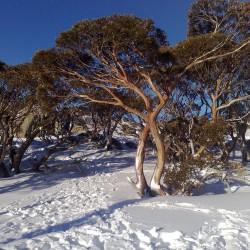Menu
-
MenuGeri
- Home
-
Kategoriler
-
-
Kategoriler
-
Sebze tohumları
-
Ülkelere Göre Çeşitler
- Ermenistan'dan çeşitler
- BH'den Çeşitler
- Hırvatistan'dan Çeşitler
- Fransa'dan Çeşitler
- Almanya'dan Çeşitler
- Yunanistan'dan Çeşitler
- Macaristan Çeşitleri
- Hindistan'dan Çeşitler
- İtalya'dan çeşitleri
- Japonya'dan Çeşitler
- Kuzey Makedonya çeşitleri
- Peru Çeşitleri
- Rusya'dan Çeşitler
- Sırbistan'dan Çeşitler
- Slovenya'dan Çeşitler
- İspanya Çeşitleri
- Tayland çeşitleri
- Türkiye'den Çeşitler
- ABD'den Çeşitler
- Domates tohumları
- Mısır tohumları
- Kabak ailesi
- Fasulye ailesi
- Salatalık tohumları
- Dolma biber tohumları
- Havuç ailesi
- Soğan ailesi
- Marul tohumları
- Patates ailesi
- Lahana ailesi
- Turp tohumları
- Pancar ailesi
- Karpuz tohumları
- Kavun tohumları
- Karnabahar tohumları
- Ayçiçeği ailesi
-
Ülkelere Göre Çeşitler
- Meyve tohumları
- Acı biber tohumları
- Tıbbi bitki tohumları
- Tırmanma bitki tohumları
- Ağaçlar - Çalı tohumları
- Palmiye tohumları
- Süs bitkileri tohumları
- Tütün tohumları
-
Sebze tohumları
-
-
-
-
- YENİ ÜRÜNLER
- Hesap oluştur
- Teslimat - Ödeme
- FAQ
- Ana Sayfa
-
- Büyük tohum paketleri
- Dev bitki tohumları
- Sebze tohumları
- Ülkelere Göre Çeşitler
- Ermenistan'dan çeşitler
- BH'den Çeşitler
- Hırvatistan'dan Çeşitler
- Fransa'dan Çeşitler
- Almanya'dan Çeşitler
- Yunanistan'dan Çeşitler
- Macaristan Çeşitleri
- Hindistan'dan Çeşitler
- İtalya'dan çeşitleri
- Japonya'dan Çeşitler
- Kuzey Makedonya çeşitleri
- Peru Çeşitleri
- Rusya'dan Çeşitler
- Sırbistan'dan Çeşitler
- Slovenya'dan Çeşitler
- İspanya Çeşitleri
- Tayland çeşitleri
- Türkiye'den Çeşitler
- ABD'den Çeşitler
- Domates tohumları
- Mısır tohumları
- Kabak ailesi
- Fasulye ailesi
- Salatalık tohumları
- Dolma biber tohumları
- Havuç ailesi
- Soğan ailesi
- Marul tohumları
- Patates ailesi
- Lahana ailesi
- Turp tohumları
- Pancar ailesi
- Karpuz tohumları
- Kavun tohumları
- Karnabahar tohumları
- Ayçiçeği ailesi
- Ülkelere Göre Çeşitler
- Meyve tohumları
- Acı biber tohumları
- Tıbbi bitki tohumları
- Tırmanma bitki tohumları
- Ağaçlar - Çalı tohumları
- Muz tohumları
- Palmiye tohumları
- Süs bitkileri tohumları
- Tütün tohumları
- Çiçek tohumları
- Kaktüs tohumları
- Su bitki tohumları
- Ekim Talimatları
- Meyve ve sebze şekil
- Mantar miselyumu
- Bitki soğanları
- Bambu tohumları
- Ayurveda Bitkileri
- F1 hibrit tohumları
- Ambalaj ve malzeme
- Cold-resistant plants
- Bitki bakımı
- Organik baharatlar
- Teslimat - Ödeme
- PayPal ve Kart ödemesi yok X
Last Product Reviews
Out of the two seeds, one germinated and the other one was dead and floatin...
By
 Riikka H on 07/03/2024
Riikka H on 07/03/2024
Verified Purchase
Çok satanlar
1289 adet ürün var.
Toplam 1289 üründen 16-30 arası gösteriliyor

Soğuğa ve dona dayanıklı bitki
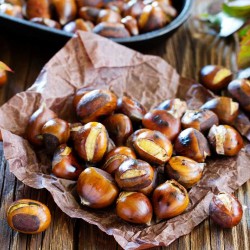
Chinese Chestnut Seeds...
Fiyat
€2,95
(SKU: V 13 C)
Seeds Gallery EU,
5/
5
<!DOCTYPE html>
<html>
<head>
<meta http-equiv="Content-Type" content="text/html; charset=UTF-8" />
</head>
<body>
<h2><strong>Chinese Chestnut Seeds (Castanea mollissima)</strong></h2>
<h2><span style="color: #ff0000;"><strong>Price for Package of 5 seeds.</strong></span></h2>
<p><span>Castanea mollissima (Chinese: 板栗; pinyin: bǎnlì), also known as Chinese chestnut, is a member of the family Fagaceae, and a species of chestnut native to China, Taiwan, and Korea.</span></p>
<p><span>It is a deciduous tree growing to 20 m tall with a broad crown. The leaves are alternate, simple, 10–22 cm long and 4.5–8 cm broad, with a toothed margin. The flowers are produced in catkins 4–20 cm long, with the female flowers at the base of the catkin and males on the rest. The fruit is a densely spiny cupule 4–8 cm diameter, containing two or three glossy brown nuts; these are 2–3 cm diameter on wild trees. The scientific name mollissima derives from the softly downy shoots and young leaves.</span></p>
<p><strong><span>Taxonomy</span></strong></p>
<p><span>Synonyms: Castanea bungeana Blume; C. duclouxii Dode; C. fargesii Dode; C. formosana (Hayata) Hayata; C. hupehensis Dode; C. mollissima var. pendula X. Y. Zhou & Z. D. Zhou; C. sativa Miller var. formosana Hayata; C. sativa var. mollissima (Blume) Pampanini; C. vulgaris Lamarck var. yunnanensis Franchet.</span></p>
<p><span>In Vietnam, Chinese chestnut (Vietnamese language: hạt dẻ, Tày language: mác lịch) which are grown in Trùng Khánh district, Cao Bằng province have highest quality with 3.3-5.4% glucose, 43.36- 46.47% glucid, 1.16 – 2% lipid, 3.12 – 3.62% protein analyzed by Vietnam National Vegetable and Fruit Researching Institution in 1999.</span></p>
<p><strong><span>Distribution and habitat</span></strong></p>
<p><span>Naturally an understory tree, Chinese chestnut has been cultivated in East Asia for millennia and its exact original range cannot be determined. In the provinces of Anhui, Fujian, Gansu, Guangdong, Guangxi, Guizhou, Hebei, Henan, Hubei, Hunan, Jiangsu, Jiangxi, Liaoning, Nei Mongol, Qinghai, Shaanxi, Shandong, Shanxi, Sichuan, Xizang, Yunnan, and Zhejiang, and also to Taiwan and Korea. It grows close to sea level in the north of its range, and at altitudes of up to 2,800 m in the south of the range. The species prefers full sun and acidic, loamy soil, and has a medium growth rate.</span></p>
<p><strong><span>Ecology</span></strong></p>
<p><span>When cultivated close to other species of chestnut (including Japanese chestnut, C. crenata; American chestnut, C. dentata; and sweet chestnut, C. sativa), Chinese chestnut readily cross-pollinates with them to form hybrids.</span></p>
<p><span>Chinese chestnuts have evolved over a long period of time in coexistence with the bark fungal disease chestnut blight (Cryphonectria parasitica, formerly Endothia parasitica), and have evolved a very successful resistance to the blight, probably more so than any other species of chestnut, so that, although it is not immune, it typically sustains no more than minor damage when infected. It's important to realize, though, that Chinese chestnut trees vary considerably in blight resistance. Some individuals are quite susceptible while others are essentially immune to the disease.[4] Japanese chestnut is also comparatively resistant to blight, with European chestnut somewhat less so. In the 1890s, Chinese and Japanese chestnuts were imported to the United States with the intention of utilizing them as orchard trees due to their small, compact size compared to the towering American chestnut. The results unfortunately were disastrous as the imported Asian species introduced blight to which C. dentata lacked any resistance. The disease was first noticed on a tree in the Brooklyn Zoo in 1902 and quickly spread all out of control, ravaging American chestnuts. Within 30 years, there were very few left in their native range. An active program has been pursued in North America to cross-breed the Chinese and American chestnuts to try to maximize various desirable traits of the American chestnut, such as larger stature, larger leaf size, larger nut size, and greater nut sweetness, while also isolating and carrying the blight resistance from the Chinese chestnut.</span></p>
<p><strong><span>Uses</span></strong></p>
<p><span>The nuts are edible, and the tree is widely cultivated in eastern Asia; over 300 cultivars have been selected for nut production, subdivided into five major regional groups: Northern, Yangtze River Valley, Sichuan and Guizhou, Southern, and Southwestern. Besides that, the Dandong chestnut (belonging to the Japanese chestnut – Castanea crenata) is a major cultivar in Liaoning Province.[6] Some cultivars, such as 'Kuling', 'Meiling', and 'Nanking', have large nuts up to 4 cm diameter. The nuts are sweet, and considered by some to have the best taste of any chestnut,[7] though others state they are not as good as the American chestnut.[8] The nuts also provide a significant food source for wildlife.</span></p>
</body>
</html>
V 13 C


Seeds Panax Ginseng, Asian...
Fiyat
€2,50
(SKU: MHS 20)
Seeds Gallery EU,
5/
5
<!DOCTYPE html>
<html>
<head>
<meta http-equiv="Content-Type" content="text/html; charset=UTF-8" />
</head>
<body>
<div id="idTab1" class="rte">
<h2><strong>Seeds Panax Ginseng, Asian Ginseng</strong></h2>
<h2><span style="color: #ff0000;"><strong>Price for Package of 5 seeds.</strong></span></h2>
<p>Panax ginseng has an ancient history. It has been used as medicine in China from more than 2000 years. It is also well known as Asian ginseng or Korean ginseng. The word ginseng is derived from Chinese word ‘Renseng’ or ‘Jinchen’ which means ‘like a man’ in accordance with their resemblance to the shape of the human body and the word Panax originates from the Latin word panacea which means ‘cure all’. Ginseng is native to China, Russia, North Korea,Japan and South Korea</p>
<p><strong>WIKIPEDIA:</strong></p>
<p>Ginseng (pronounced /ˈdʒɪnsɛŋ/[1]) is any one of 11 species of slow-growing perennial plants with fleshy roots, belonging to the genus Panax of the family Araliaceae.</p>
<p>Ginseng is found only in the Northern Hemisphere, in North America and in eastern Asia (mostly Korea, northeast China, Bhutan, and eastern Siberia), typically in cooler climates. Panax vietnamensis, discovered in Vietnam, is the southernmost ginseng known. This article focuses on the series Panax ginsengs, which are the adaptogenic herbs, principally Panax ginseng and P. quinquefolius. Ginseng is characterized by the presence of ginsenosides.</p>
<p>Siberian ginseng (Eleutherococcus senticosus) is in the same family, but not genus, as true ginseng. Like ginseng, it is considered to be an adaptogenic herb. The active compounds in Siberian ginseng are eleutherosides, not ginsenosides. Instead of a fleshy root, Siberian ginseng has a woody root.</p>
<p><strong>Etymology</strong></p>
<p>The English word ginseng derives from the Chinese term rénshēn (simplified: 人参; traditional: 人蔘). Rén means "man" and shēn means "plant root"; this refers to the root's characteristic forked shape, which resembles the legs of a man.[2] The English pronunciation derives from a southern Chinese reading, similar to Cantonese yun sum (Jyutping: jan4sam1) and the Hokkien pronunciation "jîn-sim".</p>
<p>The botanical/genus name Panax means "all-heal" in Greek, sharing the same origin as "panacea", and was applied to this genus because Linnaeus was aware of its wide use in Chinese medicine as a muscle relaxant.</p>
<p>Besides P. ginseng, many other plants are also known as or mistaken for the ginseng root. The most commonly known examples are xiyangshen, also known as American ginseng 西洋参 (P. quinquefolius), Japanese ginseng 东洋参 (P. japonicus), crown prince ginseng 太子參 (Pseudostellaria heterophylla), and Siberian ginseng[3] 刺五加 (Eleutherococcus senticosus). Although all have the name ginseng, each plant has distinctively different functions. However, true ginseng plants belong only to the Panax genus.</p>
<p><strong>Traditional uses</strong></p>
<p>The root is most often available in dried form, either whole or sliced. Ginseng leaf, although not as highly prized, is sometimes also used; as with the root, it is most often available in dried form. Folk medicine attributes various benefits to oral use of American ginseng and Asian ginseng (P. ginseng) roots, including roles as an aphrodisiac, stimulant, type II diabetes treatment, or cure for sexual dysfunction in men.</p>
<p>Ginseng may be included in small doses in energy drinks[6] or tisanes, such as ginseng coffee.[7] It may be found in hair tonics and cosmetic preparations, as well, but those uses have not been shown to be clinically effective.</p>
<p><strong>Research</strong></p>
<p>Ginsenosides, unique compounds of the Panax species, are under basic and clinical research to investigate their potential for use in medicine.</p>
<p>According to the American Cancer Society, "available scientific evidence does not support claims that ginseng is effective in preventing or treating cancer in humans".[9] Research into the potential uses of ginseng continues, although so far it has not established its benefits for treating other medical conditions either.</p>
<p>Ginseng is known to contain phytoestrogens</p>
<p><strong>Side effects</strong></p>
<p>A common side effect of P. ginseng may be insomnia,[13] but this effect is disputed.[14] Other side effects can include nausea, diarrhea, headaches, nose bleeds,[15] high blood pressure, low blood pressure, and breast pain.[16] Ginseng may also lead to induction of mania in depressed patients who mix it with antidepressants.</p>
<p>Ginseng has been shown to have adverse drug reactions with phenelzine and warfarin, but has been shown to decrease blood alcohol levels.</p>
<p><strong>Overdose</strong></p>
<p>The common adaptogen ginsengs (P. ginseng and P. quinquefolia) are generally considered to be relatively safe even in large amounts. One of the most common and characteristic symptoms of acute overdose of Panax ginseng is bleeding. Symptoms of mild overdose may include dry mouth and lips, excitation, fidgeting, irritability, tremor, palpitations, blurred vision, headache, insomnia, increased body temperature, increased blood pressure, edema, decreased appetite, dizziness, itching, eczema, early morning diarrhea, bleeding, and fatigue.</p>
<p>Symptoms of gross overdose with Panax ginseng may include nausea, vomiting, irritability, restlessness, urinary and bowel incontinence, fever, increased blood pressure, increased respiration, decreased sensitivity and reaction to light, decreased heart rate, cyanotic (blue) facial complexion, red facial complexion, seizures, convulsions, and delirium.</p>
<p>Patients experiencing any of the above symptoms are advised to discontinue the herbs and seek any necessary symptomatic treatment.</p>
<p><strong>Sowing Panax ginseng</strong></p>
<p>Soak seeds overnight in water and then wrap in damp kitchen towel and store in a sealed plastic bag for 5-8 weeks at 3-4 °C in the refrigerator. After this cooling period sow seed with sowing depth of approximately 1 cm, well moistened up at 20-25° C.</p>
<p>Germination time - after the cooling period: 10-15 weeks.</p>
<p>Without cooling period, the seeds do not germinate!</p>
<p> </p>
<h3><strong><em><span style="text-decoration: underline;">Common classification</span></em></strong></h3>
<h3><strong>Asian ginseng (root)</strong></h3>
<p>Panax ginseng is available commercially in four forms: fresh, red, white and sun ginsengs. Wild ginseng is used where available.</p>
<h3><strong>Red ginseng</strong></h3>
<p>Red ginseng (Hangul: 홍삼; Hanja: 紅蔘; RR: hong-sam; traditional Chinese: 紅蔘; simplified Chinese: 红参; pinyin: hóng shēn), P. ginseng, has been peeled, heated either through steaming at standard boiling temperatures of 100 °C (212 °F), and then dried or sun-dried. It is frequently marinated in an herbal brew which results in the root becoming extremely brittle. It is more common as herbal medicine than white ginseng. This version of ginseng is traditionally associated with stimulating sexual function and increasing energy. Red ginseng is always produced from cultivated roots, generally from Korea.</p>
<p>A study of ginseng's effects on rats found, while both white ginseng and red ginseng appear to reduce the incidence of cancer, the effects appear to be greater with red ginseng.[19]</p>
<p>Another study showed potentially beneficial effects of a combination of Korean red ginseng and highly active antiretroviral therapy in HIV-1-infected patients.[20]</p>
<p>Falcarinol, a 17-carbon diyne fatty alcohol isolated from carrot and red ginseng, was thought to have potent anticancer properties on primary mammary epithelial (breast cancer) cells.[21] Other acetylenic fatty alcohols in ginseng (panaxacol, panaxydol and panaxytriol) have antibiotic properties.</p>
<h3><strong>Fresh ginseng</strong></h3>
<p>Fresh ginseng is the raw product. Its use is limited by availability.</p>
<h3><strong>White ginseng</strong></h3>
<p>White ginseng, native to America, is fresh ginseng which has been dried without being heated. It is peeled and dried to reduce the water content to 12% or less. White ginseng air-dried in the sun may contain less of the therapeutic constituents. It is thought by some that enzymes contained in the root break down these constituents in the process of drying. Drying in the sun bleaches the root to a yellowish-white color.</p>
<h3><strong>Sun ginseng</strong></h3>
<p>Sun ginseng is created from a heat processing method which increases ginsenoside components such as ginsenoside-[Rg.sub.3], -[Rk.sub.1] and -[Rg.sub.5] by steaming white ginseng at a higher temperature than red ginseng. The herb is steamed for three hours at 120 °C (248 °F). Sun ginseng has increased nitric oxide, superoxide, hydroxyl radical and peroxynitrite scavenging activities compared with conventionally processed red or white versions. The increased steaming temperature produces an optimal amount of biological activity due to its ability to amplify specific ginsenosides.</p>
<h3><strong>Wild ginseng</strong></h3>
<p>Wild ginseng grows naturally and is harvested from wherever it is found. It is relatively rare, and even increasingly endangered, due in large part to high demand for the product in recent years, which has led to the wild plants being sought out and harvested faster than new ones can grow (it requires years for a root to reach maturity). Wild ginseng can be either Asian or American, and can be processed to be red ginseng.</p>
<p>Woods-grown American ginseng programs in Vermont, Maine, Tennessee, Virginia, North Carolina, West Virginia and Kentucky,[23][24] and United Plant Savers have been encouraging the planting of ginseng both to restore natural habitats and to remove pressure from any remaining wild ginseng, and they offer both advice and sources of rootlets. Woods-grown plants have a value comparable to wild-grown ginseng of similar age.</p>
<p>Partially germinated ginseng seeds harvested the previous Fall can be planted from early Spring until late Fall, and will sprout the following Spring. If planted in a wild setting and left to their own devices, they will develop into mature plants which cannot be distinguished from native wild plants. Both Asian and American partially germinated ginseng seeds can be bought from May through December on various eBay sales. Some seed sales come with planting and growing instructions.</p>
<h3><strong>P. quinquefolius American ginseng (root)</strong></h3>
<p>According to traditional Chinese medicine, American ginseng promotes yin energy, cleans excess yang and calms the body. The reason it has been claimed that American ginseng promotes yin (shadow, cold, negative, female) while Asian ginseng promotes yang (sunshine, hot, positive, male) is that, according to traditional Chinese medicine, things living in cold places or northern side of mountains or southern side of rivers are strong in yang and vice versa, so the two are balanced.[citation needed] Chinese/Korean ginseng grows in Manchuria and Korea, the coldest area known to many Koreans in ancient times. Thus, ginseng from there is supposed to be very yang.</p>
<p>Originally, American ginseng was imported into China via subtropical Guangzhou, the seaport next to Hong Kong, so Chinese doctors believed American ginseng must be good for yang, because it came from a hot area. They did not know, however, that American ginseng can only grow in temperate regions. Nonetheless, the root is legitimately classified as more yin because it generates fluids.[25]</p>
<p>Most North American ginseng is produced in the Canadian provinces of Ontario and British Columbia and the American state of Wisconsin, according to Agri-food Canada. P. quinquefolius is now also grown in northern China.</p>
<p>The aromatic root resembles a small parsnip that forks as it matures. The plant grows 6 to 18 in tall, usually bearing three leaves, each with three to five leaflets two to five inches long.</p>
<p><!--StartFragment--></p>
<p><strong>Sowing Panax ginseng</strong></p>
<p>Soak seeds overnight in water and then wrap in damp kitchen towel and store in a sealed plastic bag for 5-8 weeks at 3-4 °C in the refrigerator. After this cooling period sow seed with sowing depth of approximately 1 cm, well moistened up at 20-25° C.</p>
<p>Germination time - after the cooling period: 10-15 weeks.</p>
<p>Without cooling period, the seeds do not germinate!</p>
<br />
<p></p>
<p></p>
</div>
</body>
</html>
MHS 20


Dev bitki (dev meyveli)

Peru'dan Çeşitlilik
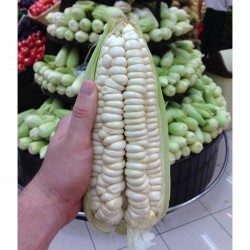
Cuzco - Cusco Dünyanın En...
Fiyat
€2,25
(SKU: P 279)
Seeds Gallery EU,
5/
5
<!DOCTYPE html>
<html>
<head>
<meta http-equiv="Content-Type" content="text/html; charset=UTF-8" />
</head>
<body>
<h2><strong>Cuzco - Cusco Dünyanın En Büyük Dev Mısır Tohumları</strong></h2>
<h2><span style="color: #ff0000;"><strong>5 veya 10 tohum paketi için fiyat.</strong></span></h2>
<p><span style="font-family: georgia, palatino, serif; font-size: 14pt;">Peru ve Ekvador'a özgü Perulu Dev Mısır - Choclo olarak da bilinir, çok geniş bir mısır çeşididir.</span></p>
<p><span style="font-family: georgia, palatino, serif; font-size: 14pt;">Saplar 5 - 5,50 metre yüksekliğe ulaşır, bu çeşitin bir çöplüğünde bir koşuşturma, 4 metrelik bir kuyrukta standart çeşitlerin üzerine yükselir.</span></p>
<p><span style="font-family: georgia, palatino, serif; font-size: 14pt;">Standart mısır çeşitlerinde ortalama ağırlık 100 çekirdek başına 25 - 35 gramdan başlar Perulu Dev Mısır'da 100 çekirdek başına ağırlık 100 çekirdek başına 90 - 95 gram arasında çalışır - bu, boyut ve verimin yaklaşık 3 katıdır.</span></p>
<p><span style="font-family: georgia, palatino, serif; font-size: 14pt;">Geç olgunlaşan bir mısırdır ve olgunlaşması için 120-150 güne ihtiyaç duyduğu tahmin edilmektedir. Üretilmesi kolay bir ürün değildir, büyümek için kararlılık ve ihtiyat gerektirir.</span></p>
<p><span style="font-family: georgia, palatino, serif; font-size: 14pt;">İnsan dağlık Andes dağlık yerli olduğunu düşünürler rüzgarlı koşullara adapte olacağını, ancak durum böyle değil. Peru Urrabamba Vadisi'nde ve korunaklı ve nispeten ılıman bir havaya sahip olan çevrede geliştiler.</span></p>
<p><span style="font-family: georgia, palatino, serif; font-size: 14pt;">Perulu Dev Mısır aka Choclo</span></p>
<p><span style="font-family: georgia, palatino, serif; font-size: 14pt;">Kuvvetli rüzgarlara dayanmazlar ve 4 - 5,50 metre yükseklikte, bir buçuk buçuk yükseklikte sürekli istiflemeye ihtiyaç duyarlar.</span></p>
<p><span style="font-family: georgia, palatino, serif; font-size: 14pt;">Bitkiler, dev çekirdekleri ile çok sayıda nispeten kısa koçanı üretir.</span></p>
<p><span style="font-family: georgia, palatino, serif; font-size: 14pt;">Tadı standart tatlı mısır ile karşılaştırılabilir. Aşırı tatlı değil - hafif ila yumuşak bir kremsi doku ile en iyi açıklama olurdu. Perulular genellikle onları kaynatır. Ekvador ve Bolivya'da, önce onları kuruturlar, sonra patlarlar ya da bir şekilde patlamış mısır gibi yağda "patlatırlar". Biz gringolar diğer mısırlarla aynı şekilde tadını çıkarabiliriz.</span></p>
<p><span style="font-family: georgia, palatino, serif; font-size: 14pt;">Mısır Sıraların aksine bloklar halinde ekilmeli ve diğer Mısır çeşitlerinin yakınına ekilmemelidir Çapraz tozlaşma kötü tatma nişastalı mısır üretme eğilimindedir. Sugar Pearl, bazı tedarikçilere göre diğer çeşitlerin yaptığı gibi izole edilmesine gerek yoktur - bu sadece Sugar Pearl için iyidir, ancak diğer çeşit değildir.</span></p>
<p><span style="font-family: georgia, palatino, serif; font-size: 14pt;">Perulu Dev Mısır doğrudan toprağa ekilebilir veya iç mekanlarda da başlatılabilir ve daha sonra nakledilebilir. İç mekanlardan başlıyorsanız, nakil süresinden önce kabı kolayca büyütebileceğinden, standarttan daha büyük bir kabınız olduğundan emin olun. Hangisini seçerseniz seçin, uygun tozlaşma ve iyi doldurulmuş kulaklar için en az dört sıra genişliğinde bloklar halinde yerleştirin</span></p>
<p><span style="font-family: georgia, palatino, serif; font-size: 14pt;">Ekim derinliği Yaklaşık: 5 cm</span></p>
<p><span style="font-family: georgia, palatino, serif; font-size: 14pt;">Çimlenme: 6 ila 8 gün</span></p>
<p><span style="font-family: georgia, palatino, serif; font-size: 14pt;">Olgunluk: 120-150 günde.</span></p>
<p><span style="font-family: georgia, palatino, serif; font-size: 14pt;">Renk: Beyaz - Soluk Sarı</span></p>
<p><span style="font-family: georgia, palatino, serif; font-size: 14pt;">Tohum Aralığı: 30-35 cm arayla.</span></p>
<p><span style="font-family: georgia, palatino, serif; font-size: 14pt;">Sıra aralığı: 100 cm</span></p>
<p><span style="font-family: georgia, palatino, serif; font-size: 14pt;">USDA Sağlamlık Bölgeleri: 3- 9</span></p>
<p><span style="font-family: georgia, palatino, serif; font-size: 14pt;">Bitki Boyutu: 400-550 cm</span></p>
<p><span style="font-family: georgia, palatino, serif; font-size: 14pt;">Mısır koçanı Boyutu: 17-20 cm Uzun</span></p>
<p><span style="font-family: georgia, palatino, serif; font-size: 14pt;">Tamamen güneş</span></p>
<p><span style="font-family: georgia, palatino, serif; font-size: 14pt;">Sq başına ortalama verim üzerinde. Video - Sap başına 3 veya daha fazla kulak bekliyoruz.</span></p>
<p><span style="font-family: georgia, palatino, serif; font-size: 14pt;">Mısır sığ köklere sahiptir ve eser elementlerin yanı sıra çok azot kullanır. Mahsulünüzün mümkün olan en iyi başlangıca ulaşmasına yardımcı olmak için, önce toprağı azot bakımından zengin bir gübre ile hazırlayın. Çürümüş gübre veya kompost da faydalıdır.</span></p>
<p><span style="font-family: georgia, palatino, serif; font-size: 14pt;">Mısır sapları bahçe bitkilerinizin geri kalanına güneş ışığını inkar edeceği için bahçenin kuzey tarafındaki bitki, ayrıca tam güneş ışığına tahammül edemeyen bitkilere gölge sağlayacak bir yerde büyümek isteyebilirsiniz.</span></p>
<h3><span style="color: #ff0000;"><strong><a href="https://www.seeds-gallery.shop/tr/home/peruvian-giant-red-sacsa-kuski-corn-seeds.html" target="_blank" title="Perulu Dev Kırmızı Sacsa Kuski Mısır Tohumları, BURADAN satın alabilirsiniz" style="color: #ff0000;" rel="noreferrer noopener">Perulu Dev Kırmızı Sacsa Kuski Mısır Tohumları, BURADAN satın alabilirsiniz</a></strong></span></h3>
</body>
</html>
P 279 5S NS

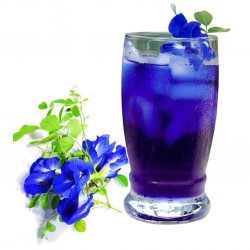
Butterfly Pea, Blue Pea...
Fiyat
€2,65
(SKU: VE 121)
Seeds Gallery EU,
5/
5
<h2 class=""><strong>Butterfly Pea, Blue Pea Vine Seeds (Clitoria ternatea)</strong></h2>
<h2><span style="color: #ff0000;"><strong>Price for Package of 5 seeds.</strong></span></h2>
<p>Clitoria ternatea, commonly known as Asian pigeonwings, bluebellvine, blue pea, butterfly pea, cordofan pea and Darwin pea, is a plant species belonging to the Fabaceae family. The flowers of this vine have the shape of human female genitals, hence the Latin name of the genus "Clitoria", from "clitoris". (Synonyms: Clitoris principissae.)</p>
<p>This plant is native to tropical equatorial Asia (Indonesia and Malaysia), but has been introduced to Africa, Australia and America.</p>
<p>It is a perennial herbaceous plant, with elliptic, obtuse leaves. It grows as a vine or creeper, doing well in moist, neutral soil. The most striking feature about this plant is the color of its flowers, a vivid deep blue; solitary, with light yellow markings. They are about 4 cm (1.6 in) long by 3 cm (1.2 in) wide. Some varieties yield white flowers.</p>
<p>The fruits are 5–7 cm (2.0–2.8 in) long, flat pods with six to ten seeds in each pod. They are edible when tender.</p>
<p>It is grown as an ornamental plant and as a revegetation species (e.g., in coal mines in Australia), requiring little care when cultivated. As a legume, its roots form a symbiotic association with soil bacteria known as rhizobia, which transform atmospheric N2 into a plant-usable form, therefore, this plant is also used to improve soil quality through the decomposition of nitrogen rich plant material.</p>
<h2><strong><em>Uses</em></strong></h2>
<h2><strong>Food</strong></h2>
<p>In Southeast Asia the flower is used as a natural food colouring. In Malay cooking, an aqueous extract is used to colour glutinous rice for kuih ketan (also known as pulut tai tai or pulut tekan in Peranakan/Nyonya cooking) and in nyonya chang. In Kelantan, east part of Malaysia, by adding a few buds of this flower in a pot while cooking white rice will add bluish tint on the rice which is served with other side dishes and such meal is called nasi kerabu. In Thailand, a syrupy blue drink is made called nam dok anchan (น้ำดอกอัญชัน), it is sometimes consumed with a drop of sweet lime juice to increase acidity and turn the juice into pink-purple. In Burmese and Thai cuisines, the flowers are also dipped in batter and fried. Butterfly pea flower tea is made from the ternatea flowers and dried lemongrass and changes color depending on what is added to the liquid, with lemon juice turning it purple.</p>
<h2><strong>Traditional medicine</strong></h2>
<p>In traditional Ayurvedic medicine, it is ascribed various qualities including memory enhancing, nootropic, antistress, anxiolytic, antidepressant, anticonvulsant, tranquilizing, and sedative properties. In traditional Chinese medicine, due to its appearance similar to the female reproductive organ, and consistent with the Western concept of the doctrine of signatures, the plant has been ascribed properties affecting this organ.</p>
<p> </p>
<p><strong>Chemical constituents</strong></p>
<p>Chemical compounds isolated from C. ternatea include various triterpenoids, flavonol glycosides, anthocyanins and steroids. Peptides known as cliotides have been isolated from the heat-stable fraction of C. ternatea extract.</p>
<h2>Growing Requirements for Butterfly Peas</h2>
<p>Unfortunately, Butterfly Pea plants are only hardy in USDA zones 10-11, but because they are such fast growers they are often grown as an annual plant in colder regions.</p>
<p>Butterfly Peas prefer to be grown in full sun but they will tolerate light shade.</p>
<p>These are very drought tolerant plants, but they should be watered regularly for the best results.</p>
<p>Never over water Butterfly Peas!</p>
<p>Pinch regularly to induce bushiness.</p>
<p>Butterfly Pea seed pods are edible and tasty.</p>
<h2>Growing Butterfly Pea Vines from Seed</h2>
<p>The seeds of the Butterfly Pea should be nicked or filed, then soaked overnight in room temperature water before planting.</p>
<p>They can be sown directly in the garden with 3-4 inch spacing when the soil warms in the spring.</p>
<p>Start seeds indoors 12 weeks before the warm weather arrives, maintaining a temperature within the growing medium of 70°-75° F.</p>
<p>Germination takes 15-20 days.</p>
<table cellspacing="0" cellpadding="0" border="1">
<tbody>
<tr>
<td colspan="2" width="100%" valign="top">
<h2 align="center"><strong>Sowing Instructions</strong></h2>
</td>
</tr>
<tr>
<td valign="top" nowrap="nowrap">
<p align="center"><strong>Propagation:</strong></p>
</td>
<td valign="top">
<p align="center">Seeds</p>
</td>
</tr>
<tr>
<td valign="top" nowrap="nowrap">
<p align="center"><strong>Pretreat:</strong></p>
</td>
<td valign="top">
<p align="center">Carefully scarify seeds with a knife, or roughen with sandpaper.</p>
<p align="center">Then soak in warm water for 12 h.</p>
</td>
</tr>
<tr>
<td valign="top" nowrap="nowrap">
<p align="center"><strong>Stratification:</strong></p>
</td>
<td valign="top">
<p align="center">0</p>
</td>
</tr>
<tr>
<td valign="top" nowrap="nowrap">
<p align="center"><strong>Sowing Time:</strong></p>
</td>
<td valign="top">
<p align="center">all year round </p>
</td>
</tr>
<tr>
<td valign="top" nowrap="nowrap">
<p align="center"><strong>Sowing Depth:</strong></p>
</td>
<td valign="top">
<p align="center">0,5 cm</p>
</td>
</tr>
<tr>
<td valign="top" nowrap="nowrap">
<p align="center"><strong>Sowing Mix:</strong></p>
</td>
<td valign="top">
<p align="center">Coir or sowing mix + sand or perlite</p>
</td>
</tr>
<tr>
<td valign="top" nowrap="nowrap">
<p align="center"><strong>Germination temperature:</strong></p>
</td>
<td valign="top">
<p align="center">25-28°C</p>
</td>
</tr>
<tr>
<td valign="top" nowrap="nowrap">
<p align="center"><strong>Location:</strong></p>
</td>
<td valign="top">
<p align="center">bright + keep constantly moist, <strong>but not wet!</strong></p>
</td>
</tr>
<tr>
<td valign="top" nowrap="nowrap">
<p align="center"><strong>Germination Time:</strong></p>
</td>
<td valign="top">
<p align="center">3-6 weeks</p>
</td>
</tr>
<tr>
<td valign="top" nowrap="nowrap">
<p align="center"><strong>Watering:</strong></p>
</td>
<td valign="top">
<p align="center">in the growing season moderate water + let dry between watering</p>
</td>
</tr>
<tr>
<td valign="top" nowrap="nowrap">
<p align="center"><strong> </strong></p>
</td>
<td valign="top">
<p><strong><em>Copyright © 2012 Seeds Gallery - Saatgut Galerie - Galerija semena. </em></strong></p>
<p align="center"><strong><em>All Rights Reserved.</em></strong></p>
</td>
</tr>
</tbody>
</table>
<p> </p>
<script src="//cdn.public.n1ed.com/G3OMDFLT/widgets.js"></script>
VE 121 (5 S)

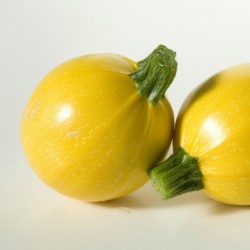
Yellow Round Squash -...
Fiyat
€1,95
(SKU: VG 48)
Seeds Gallery EU,
5/
5
<h2><strong>Yellow Round Squash - Zucchini Seeds</strong></h2>
<h2><span style="color:#ff0000;"><strong>Price for Package of 5 seeds.</strong></span></h2>
<p>Brings many yellow round fruits with a diameter of 12 cm. Particularly delicate and pleasantly aromatic, for gourmets. The apple-sized round fruits of this cultivation are an insider tip among gourmets.</p>
<p>Similar to the yellow zucchini or the green fruits of the "Satelite" variety, they are particularly tender and have a wonderfully mild aromatic taste in their youth.</p>
<p>With their golden yellow color, they look appealingly delicious in raw food or salads. They also taste sliced and steamed as an accompaniment to meat and Mediterranean grills and fish dishes.</p>
<p>The bushy plants are vigorous and carry an astonishingly large amount of fruit when continuously picked.</p>
<p><strong>CULTURE:</strong></p>
<p>Fertile, well-drained soil with a pH of 5.8–6.8 is best. Plastic mulch and fabric row covers (AG-19 grade) can aide plant establishment and exclude insect pests during the seedling stage. Row covers should be removed when plants begin to flower. Poor fruit development may indicate insufficient pollination. For the highest quality fruit, succession plantings every 2-3 weeks may be needed.</p>
<p><strong>PLANT SPACING:</strong></p>
<p>Space plants 18-24" apart in rows 6' apart. Wider spacing may allow for easier harvesting.</p>
VG 48 (5 S)


İtalya'dan çeşitli
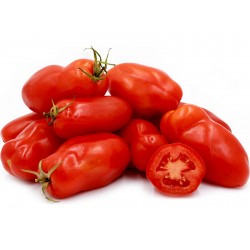
Domates Tohumları SAN...
Fiyat
€1,65
(SKU: VT 35)
Seeds Gallery EU,
5/
5
<h2><strong>Domates Tohumları SAN MARZANO 2</strong></h2><h2><span style="color:#ff0000;"><strong>5 veya 10 tohumluk Paket Fiyatı</strong></span></h2><p>San Marzano domatesleri birçok şef tarafından dünyanın en iyi sos domatesleri olarak kabul edilir. Tomate San Marzano'nun fantastik tarihi, 1770 yılında Peru Krallığı'ndan Napoli, İtalya yakınlarındaki San Marzano komünü alanına dikilmiş olan Napoli Krallığı'na bir hediye olarak başlar.</p><p>İlk bitkiler, Vezüv Yanardağı'nın gölgesinde volkanik toprakta yetiştirildi. Roma'nın en iyi bilinen domatesleri (Brezilya'daki İtalyan Domatesleri) ile karşılaştırıldığında, Marzano'nun domatesleri daha incedir ve daha sivri bir şekle sahiptir.</p><p>Yaklaşık 10 cm uzunluğunda oval kırmızı meyveler, tüm domates mevsiminde eşsiz aromatik keyfi temsil eder. Et, daha az tohumla çok daha kalındır ve tadı çok daha güçlü, daha tatlı ve daha az asidiktir.</p><p>Birçok insan tadı, yüksek kaliteli çikolata gibi acı tatlı olarak tanımlar. Yüksek kaliteleri ve Napoli yakınlarındaki kökenleri nedeniyle, Marzano de São domatesleri Vera Pizza Napoletana (Napoli'de Gerçek Pizza) için kullanılabilecek tek domates olarak belirlenmiştir.</p><br /><div>Marzano çeşidinin ticari üretimi en çok İtalya ile ilişkili olsa da, çeşit için tohumlar dünya çapında yetiştirilir, genellikle geleneksel bir İtalyan çeşidi olarak etiketlenir ve en yaygın çeşitlerden daha pahalı bir fiyata satılır.</div>
VT 35 (5 S)

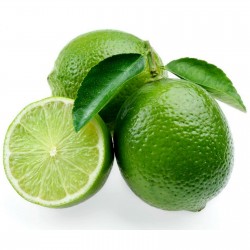
İran kireç tohumları...
Fiyat
€1,95
(SKU: V 119)
Seeds Gallery EU,
5/
5
<!DOCTYPE html>
<html>
<head>
<meta http-equiv="Content-Type" content="text/html; charset=UTF-8" />
</head>
<body>
<h2><strong>İran kireç tohumları (Citrus × latifolia)</strong></h2>
<h2><span style="color: #ff0000;"><strong>2 tohum paketi için fiyat.</strong></span></h2>
<p>Pers kireci (Citrus × latifolia) veya limoo aynı zamanda Tahiti kireç veya Bearss kireci olarak da bilinir (bu çekirdeksiz çeşidi 1895 yılında Porterville, California'daki fidanlığında geliştiren John T. Bearss'den almıştır), standartla ilgili bir narenciye Misket Limonu.</p>
<p>Eşsiz kokulu, baharatlı bir aroması vardır. Meyvenin çapı yaklaşık 6 cm olup, uçları hafif nipellidir ve tam olgunluğa ulaştığında sararmasına rağmen genellikle yeşil renkte satılır. Ayrıca İran yemeklerinde bu şekilde sıklıkla kullanıldığı için yaygın olarak kurutulmuş olarak bulunur. Daha büyük, daha kalın kabukludur ve açık kireçten (Citrus aurantifolia) daha az yoğun narenciye aromatikleri içerir.</p>
<p>Ticari tarımda İran kirecinin Key kireç ile karşılaştırıldığında avantajları daha büyük olması, tohum yokluğu, sertliği, çalılarda diken olmaması ve meyve raf ömrünün daha uzun olmasıdır. Anahtar limonlardan daha az asidiktirler ve ana kirecin benzersiz lezzetini ödünç veren acılığa sahip değildirler.</p>
<p>Farsça kireçler, 110'lar, 150'ler, 175'ler, 200'ler, 230'lar ve 250'ler olarak bilinen altı boyutta satılır. Öncelikle ABD'de Florida'da yetiştirildikten sonra, Amerikan Pomoloji Derneği'ne göre, Key kireç bahçelerinin 1926'da bir kasırga tarafından yok edilmesinden sonra, İran ıhlamur bahçelerinin kendisi 1992'de Andrew Kasırgası tarafından harap edildi.</p>
<p>Her yıl çok sayıda İran limonu yetiştirilir, işlenir ve başlıca Meksika'dan Amerika, Avrupa ve Asya pazarlarına ihraç edilir. Meksika'dan ABD'nin İran kireci ithalatı çoğunlukla McAllen, Teksas üzerinden yapılmaktadır.</p>
<p>İran kireçleri Uzak Doğu'dan gelir ve ilk olarak İran'da (şimdi İran) ve güney Irak'ta büyük ölçekte yetiştirildi.</p>
<p>ersia (now Iran) and southern Iraq.</p>
</body>
</html>
V 119

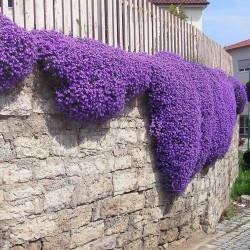
Sürünen Kekik, Breckland...
Fiyat
€1,95
(SKU: MHS 111)
Seeds Gallery EU,
5/
5
<h2><strong>Sürünen Kekik, Breckland Kekik tohumu (Thymus Serpyllum)</strong></h2>
<h2><span style="color:#ff0000;"><strong>50 tohum paketi için fiyat.</strong></span></h2>
<p>Aynı zamanda Breckland Kekik olarak da bilinen Sürünen Kekik, kurutulmuş sürgünleri tıbbi amaçlar için yaygın olarak kullanılan çok yıllık bir bitkidir. Kurutulmuş halde kullanıldığında, cilt üzerinde yararlı bir etkiye sahiptir; kan dolaşımını arttırmanın yanı sıra cildi dezenfekte eder ve sıkarlar. Bu çeşitlilik ayrıca idrar yolu enfeksiyonlarını tedavi etmek ve sindirim problemlerine yardımcı olmak için kullanılırken, inhalasyon için kullanılırken üst hava geçişlerini dezenfekte eder. Sadece Sürünen Kekik tıbbi özellikleri nedeniyle çok değerli değil, aynı zamanda taş döşemelerinde yetiştirilmesi tavsiye edilen seçkin bir süs bitkisidir. </p>
<p>Büyüyen: tohumları nisandan hazirana kadar ekin. Ağustos ayından eylül ayına kadar 20x20cm aralıklarla kalıcı bir yere dikin. Bu çeşitlilik haziran-ağustos ayları arasındadır. </p>
MHS 111 (50 S)


Dev bitki (dev meyveli)
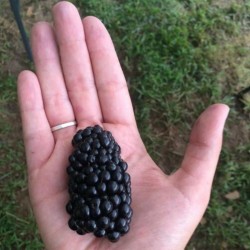
Dev Böğürtlen Tohumları...
Fiyat
€1,85
(SKU: V 126)
Seeds Gallery EU,
5/
5
<!DOCTYPE html>
<html>
<head>
<meta http-equiv="Content-Type" content="text/html; charset=UTF-8" />
</head>
<body>
<h2>Dev Böğürtlen Tohumları (Rubus fruticosus)</h2>
<h2><span style="color: #ff0000;"><strong>10 veya 20 tohum paketi için fiyat.</strong></span></h2>
<p><strong>Bu çeşit, meyve başına 10 gram ağırlığında son derece büyük meyveler üretir.</strong></p>
<p>The healthful benefits are many, rich in vitamin C, vitamin K, B vitamin, Omega-3, Manganese. Antioxidant strength at top of more than 1000 antioxidant foods consumed in the U.S.</p>
<p><strong>Wikipedia:</strong></p>
<p>The blackberry is an edible fruit produced by many species in the Rubus genus in the Rosaceae family, hybrids among these species within the Rubus subgenus, and hybrids between the Rubus and Idaeobatus subgenera. What distinguishes the blackberry from its raspberry relatives is whether or not the torus (receptacle or stem) 'picks-with' (i.e. stays with) the fruit. When picking a blackberry fruit, the torus does stay with the fruit. With a raspberry, the torus remains on the plant, leaving a hollow core in the raspberry fruit. The term 'bramble', a word meaning any impenetrable scrub, has traditionally been applied specifically to the blackberry or its products,[1] though in the United States it applies to all members of the Rubus genus. In the western US, the term caneberry is used to refer to blackberries and raspberries as a group rather than the term bramble.</p>
<p>The usually black fruit is not a berry in the botanical sense of the word. Botanically it is termed an aggregate fruit, composed of small drupelets. It is a widespread and well-known group of over 375 species, many of which are closely related apomictic microspecies native throughout Europe, northwestern Africa, temperate western and central Asia and North and South America.</p>
<p><strong>Growth and anatomical description</strong></p>
<p>Blackberries are perennial plants which typically bear biennial stems ("canes") from the perennial root system.</p>
<p>In its first year, a new stem, the primocane, grows vigorously to its full length of 3–6 m (in some cases, up to 9 m), arching or trailing along the ground and bearing large palmately compound leaves with five or seven leaflets; it does not produce any flowers. In its second year, the cane becomes a floricane and the stem does not grow longer, but the lateral buds break to produce flowering laterals (which have smaller leaves with three or five leaflets).[3] First- and second-year shoots usually have numerous short-curved, very sharp prickles that are often erroneously called thorns. These prickles can tear through denim with ease and make the plant very difficult to navigate around. Prickle-free cultivars have been developed. Recently the University of Arkansas has developed primocane fruiting blackberries that grow and flower on first-year growth much as the primocane-fruiting (also called fall bearing or everbearing) red raspberries do.</p>
<p>Unmanaged mature plants form a tangle of dense arching stems, the branches rooting from the node tip on many species when they reach the ground. Vigorous and growing rapidly in woods, scrub, hillsides, and hedgerows, blackberry shrubs tolerate poor soils, readily colonizing wasteland, ditches, and vacant lots.</p>
<p>The flowers are produced in late spring and early summer on short racemes on the tips of the flowering laterals.[3] Each flower is about 2–3 cm in diameter with five white or pale pink petals.[3]</p>
<p>The drupelets only develop around ovules that are fertilized by the male gamete from a pollen grain. The most likely cause of undeveloped ovules is inadequate pollinator visits.[5] Even a small change in conditions, such as a rainy day or a day too hot for bees to work after early morning, can reduce the number of bee visits to the flower, thus reducing the quality of the fruit. Incomplete drupelet development can also be a symptom of exhausted reserves in the plant's roots or infection with a virus such as Raspberry bushy dwarf virus.</p>
<p>In botanical terminology, the fruit is not a berry but an aggregate fruit of numerous drupelets.</p>
<p><strong>Ecology</strong></p>
<p>Blackberry leaves are food for certain caterpillars; some grazing mammals, especially deer, are also very fond of the leaves. Caterpillars of the concealer moth Alabonia geoffrella have been found feeding inside dead blackberry shoots. When mature, the berries are eaten and their seeds dispersed by several mammals, such as the red fox and the Eurasian badger, as well as by small birds.</p>
<p>Blackberries grow wild throughout all parts of the United Kingdom and Ireland. They are an important element in the ecology of those countries. Harvesting the berries is a popular pastime in these countries. However, it is also considered an invasive weed, sending down its strong suckering roots amongst garden hedges and shrubs. In some parts of the world, such as in Australia, Chile, New Zealand, and the Pacific Northwest of North America, some blackberry species, particularly Rubus armeniacus (syn. R. procerus, 'Himalaya') and Rubus laciniatus ('Evergreen'), are naturalised and considered an invasive species and a serious weed.</p>
<p>The blackberry tends to be red during its unripe ("green") phase, leading to an old expression that "blackberries are red when they're green".</p>
<p>In various parts of the United States, wild blackberries are sometimes called "Black-caps", a term more commonly used for black raspberries, Rubus occidentalis.</p>
<p>As there is forensic evidence from the Iron Age Haraldskær Woman that she consumed blackberries some 2500 years ago, it is reasonable to conclude that blackberries have been eaten by humans over thousands of years.</p>
<p><strong><em>Uses</em></strong></p>
<p><strong>Food</strong></p>
<p>The soft fruit is popular for use in desserts, jams, seedless jelly, and sometimes wine. It is often mixed with apples for pies and crumbles. Blackberries are also used to produce candy.</p>
<p>Good nectar producers, blackberry shrubs bearing flowers yield a medium to dark, fruity honey.</p>
<p><strong>Phytochemical research</strong></p>
<p>Blackberries contain numerous phytochemicals including polyphenols, flavonoids, anthocyanins, salicylic acid, ellagic acid, and fiber.[7][8] Anthocyanins in blackberries are responsible for their rich dark color.</p>
<p>Phytochemical components of blackberries, salicylic acid and ellagic acid have been associated in preliminary research with toxicity to cancer cells,[9][10] including breast cancer cells.</p>
<p>Blackberries rank highly among fruits for in vitro antioxidant strength, particularly because of their dense content of polyphenolic compounds, such as ellagic acid, tannins, ellagitannins, quercetin, gallic acid, anthocyanins, and cyanidins.[12][13] One report placed blackberry at the top of more than 1000 antioxidant foods consumed in the United States.</p>
<p><strong>Nutrients</strong></p>
<p>Blackberries are notable for their high nutritional contents of dietary fiber, vitamin C, vitamin K, and the essential mineral manganese.</p>
<p>Blackberries have both soluble and insoluble fiber.[15] One cup of blackberries (144 g) has an average of 7.6 g of fibre and contains half the daily recommended dose of vitamin C.[8] Dietary fiber is important in maintaining a healthy digestive system, as it supports regular bowel movements.</p>
<p><strong>Nutrient content of seeds</strong></p>
<p>Blackberries contain numerous large seeds that are not always preferred by consumers. The seeds contain oil rich in omega-3 (alpha-linolenic acid) and -6 fats (linoleic acid) as well as protein, dietary fiber, carotenoids, ellagitannins and ellagic acid.</p>
<p><strong><em>Cultivation</em></strong></p>
<p><strong>Commercial cultivation</strong></p>
<p>Worldwide, Mexico is the leading producer of blackberries, with nearly the entire crop being produced for export into the off-season fresh markets in North America and Europe. The Mexican market is almost entirely from the cultivar 'Tupy' (often spelled 'Tupi', but the EMBRAPA program in Brazil from which it was released prefers the 'Tupy' spelling.). In the US, Oregon is the leading commercial blackberry producer, producing 42.6 million pounds on 6,180 acres (25.0 km2), in 1995[17] and 56.1 million pounds on 7,000 acres (28 km2) in 2009.</p>
<p>Numerous cultivars have been selected for commercial and amateur cultivation in Europe[2] and the United States.[19] Since the many species form hybrids easily, there are numerous cultivars with more than one species in their ancestry.</p>
<p>'Marion' (marketed as "marionberry") is an important cultivar that was selected from seedlings from a cross between 'Chehalem' and 'Olallie' (commonly called "olallieberry") berries.[20] 'Olallie' in turn is a cross between loganberry and youngberry. 'Marion', 'Chehalem' and 'Olallie' are just three of many trailing blackberry cultivars developed by the United States Department of Agriculture Agricultural Research Service (USDA-ARS) blackberry breeding program at Oregon State University in Corvallis, Oregon.</p>
<p>The most recent cultivars released from this program are the prickle-free cultivars 'Black Diamond', 'Black Pearl', and 'Nightfall' as well as the very early-ripening 'Obsidian' and 'Metolius'. 'Black Diamond' is now the leading cultivar being planted in the Pacific Northwest. Some of the other cultivars from this program are 'Newberry', 'Waldo', 'Siskiyou', 'Black Butte', 'Kotata', 'Pacific', and 'Cascade'.</p>
<p>Trailing blackberries are vigorous and crown forming, require a trellis for support, and are less cold hardy than the erect or semi-erect blackberries. In addition to the United States's Pacific Northwest, these types do well in similar climates such as the United Kingdom, New Zealand, Chile, and the Mediterranean countries.</p>
<p>Semi-erect, prickle-free blackberries were first developed at the John Innes Centre in Norwich, UK, and subsequently by the USDA-ARS in Beltsville, Maryland. These are crown forming and very vigorous and need a trellis for support. Cultivars include 'Black Satin' 'Chester Thornless', 'Dirksen Thornless', 'Hull Thornless', 'Loch Ness', 'Loch Tay', 'Merton Thornless', 'Smoothstem', and 'Triple Crown'. Recently, the cultivar 'Cacanska Bestrna' (also called 'Cacak Thornless') has been developed in Serbia and has been planted on many thousands of hectares there.</p>
<p>The University of Arkansas has developed cultivars of erect blackberries. These types are less vigorous than the semi-erect types and produce new canes from root initials (therefore they spread underground like raspberries). There are prickly and prickle-free cultivars from this program, including 'Navaho', 'Ouachita', 'Cherokee', 'Apache', 'Arapaho', and 'Kiowa'. They are also responsible for developing the primocane fruiting blackberries such as 'Prime-Jan' and 'Prime-Jim'.</p>
<p>In raspberries, these types are called primocane fruiting, fall fruiting, or everbearing. 'Prime-Jim' and 'Prime-Jan' were released in 2004 by the University of Arkansas and are the first cultivars of primocane fruiting blackberry.[22] They grow much like the other erect cultivars described above, however the canes that emerge in the spring, will flower in mid-summer and fruit in late summer or fall. The fall crop has its highest quality when it ripens in cool mild climate such as in California or the Pacific Northwest.</p>
<p>'Illini Hardy' a semi-erect prickly cultivar introduced by the University of Illinois is cane hardy in zone 5, where traditionally blackberry production has been problematic, since canes often failed to survive the winter.</p>
<p>Blackberry production in Mexico has expanded enormously in the past decade. While once based on the cultivar 'Brazos', an old erect blackberry cultivar developed in Texas in 1959, the Mexican industry is now dominated by the Brazilian 'Tupy' released in the 1990s. 'Tupy' has the erect blackberry 'Comanche', and a "wild Uruguayan blackberry" as parents.[23] Since there are no native blackberries in Uruguay, the suspicion is that the widely grown 'Boysenberry' is the male parent. In order to produce these blackberries in regions of Mexico where there is no winter chilling to stimulate flower bud development, chemical defoliation and application of growth regulators are used to bring the plants into bloom.</p>
<p><strong>Diseases and pests</strong></p>
<p>As a result of blackberries belonging to the same genus as raspberries,[24] they share the same diseases including anthracnose which can cause the berry to have uneven ripening and sap flow may also be slowed.[25][26] They also share the same remedies including the Bordeaux mixture,[27] a combination of lime, water and Copper(II) sulfate.[28] The rows between blackberry plants must be free of weeds, blackberry suckers and grasses which may lead to pests or diseases.[29] Fruit growers are selective when planting blackberry bushes as wild blackberries may be infected[29] and gardeners are recommended to purchase only certified disease-free plants.</p>
<p>The spotted-wing drosophila, Drosophila suzukii is a serious pest of blackberries.[31] Unlike its vinegar fly relatives which are primarily attracted to rotting or fermented fruit, D. suzukii attacks fresh, ripe fruit by laying eggs under the soft skin. The larvae hatch and grow in the fruit, destroying the fruit's commercial value.</p>
<p>Another pest is Amphorophora rubi, known as the Blackberry Aphid, which not only eats blackberries but raspberries as well.</p>
<p> Byturus tomentosus (Raspberry beetle), Lampronia corticella (Raspberry Moth) and Anthonomus rubi (Strawberry blossom weevil) are also known to infest blackberries.</p>
<p><strong>Folklore</strong></p>
<p>Folklore in the United Kingdom is told that blackberries should not be picked after Old Michaelmas Day (11 October) as the devil has claimed them. There is some value behind this legend as wetter and cooler weather often allows the fruit to become infected by various molds such as Botryotinia which give the fruit an unpleasant look and may be toxic.</p>
</body>
</html>
V 126


Dev bitki (dev meyveli)

Giant Bamboo seeds...
Fiyat
€2,15
(SKU: B 1)
Seeds Gallery EU,
5/
5
<h2><strong>Giant Bamboo seeds (Phyllostachys pubescens)</strong></h2>
<h2><span style="color: #ff0000;"><strong>Price for Package of 10 or 20 seeds.</strong></span></h2>
<p>Phyllostachys pubescens, common name Moso bamboo is a monopodial bamboo, An absolute giant in all respects, with blue-green culms (canes) and dense arching foliage and have a fuzzy texture. The distinctive internodes are very short near the ground, then lengthen to a foot or more higher up the culm.</p>
<p>The leaves are smaller than those of many other bamboos and present a pleasant contrast to the massive culms. Moso bamboo pole stalks are considered among the biggest and most beautiful, growing to a diameter from 3 to 7 inches and towering to 80 feet with clusters of relatively small green leaves.</p>
<p>Native to China and Japan, the stems have many uses.</p>
<p>This species is the major source of edible bamboo shoots. It is hardy to 10F, Zone 10 in the USA. Ideal growing temperature is 72 F and higher.</p>
<div>
<p><iframe width="640" height="385" src="https://www.youtube.com/embed/6ngy_TDW03c?rel=0&hd=1" frameborder="0" class="embed-responsive-item"> </iframe></p>
</div>
B 1 (10 S)


Dev bitki (dev meyveli)

Amerika Birleşik Devletleri'nden çeşitli
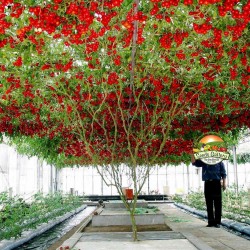
Dev İtalyan domates ağacı...
Fiyat
€2,85
(SKU: VT 6)
Seeds Gallery EU,
5/
5
<!DOCTYPE html>
<html>
<head>
<meta http-equiv="Content-Type" content="text/html; charset=UTF-8" />
</head>
<body>
<h2><strong>Dev İtalyan domates ağacı tohumları</strong></h2>
<h2><span style="color: #ff0000;"><strong>5 tohum paketi için fiyat.</strong></span></h2>
<p>Ünlü İtalyan Ağacı Domates, 15 cm boyunda büyüyen büyük kızıl domates üretir! Katı bölümleri olan etli merkezleri var. Şimdiye kadar en verimli domates, genellikle sadece bir bitkiden 3 kile üretiyor!</p>
<p>Bir kafes üzerinde yetiştirildiğinde sarmaşıklar 5,5 metre ve sıklıkla 7,5 metreye yükselir. Bir kafes olmadan bile, Ünlü İtalyan Ağacı domatesleri diğer çeşitleri ortaya çıkaracaktır. Bitkilerin kurulmasından ilk meyvelerin olgunlaşmasına kadar 70 gün ...</p>
</body>
</html>
VT 6 (5 S)


Bu ürün en çok satan üründür
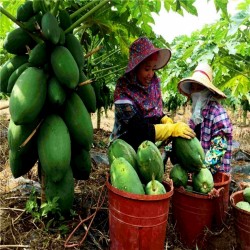
Indian Dwarf Papaya Seeds -...
Fiyat
€3,00
(SKU: V 22 M)
Seeds Gallery EU,
5/
5
<h2 class=""><strong>Indian Dwarf Papaya Seeds - Paw Paw Miniature</strong></h2>
<h2><span style="color: #ff0000;"><strong>Price for Package of 10 or 100 seeds.</strong></span></h2>
<p><a href="https://www.seeds-gallery.shop/en/home/indian-dwarf-papaya-seeds-paw-paw-miniature.html" target="_blank" rel="noreferrer noopener"><strong>Tropical Dwarf Papaya is fast-growing papaya it only reaches 170 cm to 200 cm but bears fruits as large as 1 kg in 6-8 months from seed.</strong></a></p>
<p>Papaya (Carica papaya L.) - Deliciously sweet with musky undertones and a soft, butter-like consistency, it is no wonder the papaya was reputably called the "fruit of the angels" by Christopher Columbus. Once considered quite exotic, they can now be found in markets throughout the year. Although there is a slight seasonal peak in early summer and fall, papaya trees produce fruit year-round. </p>
<p>Papayas are fruits that remind us of the tropics, the regions of the world in which they are grown. Once considered an exotic fruit, papayas' rise in popularity has made them much more available. Papaya fruits are good sources of Vitamin A, B, and C. </p>
<p>Papayas are spherical or pear-shaped fruits that can be as long as 20 inches. The ones commonly found in the market usually average about 7 inches and weigh about one pound. Their flesh is a rich orange color with either yellow or pink hues. </p>
<p>Papaya has a wonderfully soft, butter-like consistency and a deliciously sweet, musky taste. Inside the inner cavity of the fruit are black, round seeds encased in a gelatinous-like substance. Papaya's seeds are edible, although their peppery flavor is somewhat bitter. </p>
<p>The fruit, as well as the other parts of the papaya tree, contain papain, an enzyme that helps digest proteins. This enzyme is especially concentrated in the fruit when it is unripe. Papain is extracted to make digestive enzyme dietary supplements and is also used as an ingredient in some chewing gums. </p>
<h2><a href="https://www.seeds-gallery.shop/en/home/indian-dwarf-papaya-seeds-paw-paw-miniature.html" target="_blank" title="How To Grow Papaya From Seed" rel="noreferrer noopener"><strong>How To Grow Papaya From Seed</strong></a></h2>
<p>Select a sunny and sheltered place in your garden. That's right, in your garden. Don't start them in pots!</p>
<p>Papayas don't transplant well. Anything that disturbs the roots of papayas really sets them back. They just hate it. The most foolproof way to grow papayas is to simply plant them where they are to live.</p>
<p>Papaya trees are very, very hungry. That means they need very good soil, rich in organic matter and nutrients.</p>
<p>If you don't have fabulous soil, make some. Dig a hole half a meter across and fill it with a mix of good compost and soil. Actually, make at least two or three such planting beds in different locations.</p>
<p>Now sprinkle on some of your seeds. A couple of dozen per bed is a good amount. Cover the seeds lightly with more compost, and then mulch the patch well. The seeds usually take about a couple of weeks to germinate and may take longer.</p>
<p>Soon you will notice that your seedlings are very different in size and vigor. That's why we planted so many. Start culling the weaker ones. Pull them out while still small, or cut bigger ones down to the ground. Only keep the very best.</p>
<p>At this stage, you should keep about half a dozen plants. Papaya plants can be male, female, or bisexual, and you want to make sure that you have some females or bisexual plants amongst your seedlings. The male papayas don't bear fruit.</p>
<p>Papayas start flowering when they are about one meter tall. The male's flower first. Male flowers have long, thin stalks with several small blooms. Female flowers are usually single blooms, bigger, and very close to the trunk. </p>
<p>Cull most of the male plants. You only need one male for every ten to fifteen female plants to ensure good pollination.</p>
<p>And that's it. You should end up with one very strong and healthy female plant per bed. (And a male plant somewhere...) If the weather is warm enough, and if you are growing your papayas in full sun and in good soil, then you could be picking the first ripe fruit within 10 months.</p>
<h3>How much water?</h3>
<p>Papayas have large soft leaves. They evaporate a lot of water in warm weather, so they need a lot of water. But unfortunately, papayas are very susceptible to root rot, especially in cool weather. Overwatering is the most common reason for problems when growing papayas.</p>
<p>It depends on the temperature and on the overall health and vigor of the plant. A healthier plant will cope better, but in general, you should be careful not to overwater during periods of cool weather.</p>
<h3>Growing Papaya In Cooler Climates</h3>
<p>If you get at least long hot summers you could grow papaya just as an ornamental plant. In this case, you would start them in a pot indoors to gain extra time. Plant them out against a sun-facing wall and enjoy the tropical look. However, you won't be able to keep your papaya alive long enough to get fruit.</p>
<p>The only other option is growing papaya in a huge pot, and to keep the pot in a heated greenhouse in winter. You may also grow papaya as an annual decorative plant.</p>
<div>
<table cellspacing="0" cellpadding="0" border="1">
<tbody>
<tr>
<td colspan="2" width="100%" valign="top">
<p><span style="color: #008000;"><strong>Sowing Instructions</strong></span></p>
</td>
</tr>
<tr>
<td valign="top" nowrap="nowrap">
<p><span style="color: #008000;"><strong>Propagation:</strong></span></p>
</td>
<td valign="top">
<p><span style="color: #008000;">Seeds / Cuttings</span></p>
</td>
</tr>
<tr>
<td valign="top" nowrap="nowrap">
<p><span style="color: #008000;"><strong>Pretreat:</strong></span></p>
</td>
<td valign="top">
<p><span style="color: #008000;">0</span></p>
</td>
</tr>
<tr>
<td valign="top" nowrap="nowrap">
<p><span style="color: #008000;"><strong>Stratification:</strong></span></p>
</td>
<td valign="top">
<p><span style="color: #008000;">0</span></p>
</td>
</tr>
<tr>
<td valign="top" nowrap="nowrap">
<p><span style="color: #008000;"><strong>Sowing Time:</strong></span></p>
</td>
<td valign="top">
<p><span style="color: #008000;">all year round</span></p>
</td>
</tr>
<tr>
<td valign="top" nowrap="nowrap">
<p><span style="color: #008000;"><strong>Sowing Depth:</strong></span></p>
</td>
<td valign="top">
<p><span style="color: #008000;">0.5 cm</span></p>
</td>
</tr>
<tr>
<td valign="top" nowrap="nowrap">
<p><span style="color: #008000;"><strong>Sowing Mix:</strong></span></p>
</td>
<td valign="top">
<p><span style="color: #008000;">Coir or sowing mix + sand or perlite</span></p>
</td>
</tr>
<tr>
<td valign="top" nowrap="nowrap">
<p><span style="color: #008000;"><strong>Germination temperature:</strong></span></p>
</td>
<td valign="top">
<p><span style="color: #008000;">about 25-28 ° C</span></p>
</td>
</tr>
<tr>
<td valign="top" nowrap="nowrap">
<p><span style="color: #008000;"><strong>Location:</strong></span></p>
</td>
<td valign="top">
<p><span style="color: #008000;">bright + keep constantly moist not wet</span></p>
</td>
</tr>
<tr>
<td valign="top" nowrap="nowrap">
<p><span style="color: #008000;"><strong>Germination Time:</strong></span></p>
</td>
<td valign="top">
<p><span style="color: #008000;">2-4 Weeks</span></p>
</td>
</tr>
<tr>
<td valign="top" nowrap="nowrap">
<p><span style="color: #008000;"><strong>Watering:</strong></span></p>
</td>
<td valign="top">
<p><span style="color: #008000;">regular watering during the growth period + dry between waterings</span></p>
</td>
</tr>
<tr>
<td valign="top" nowrap="nowrap">
<p><span style="color: #008000;"><strong> </strong></span></p>
</td>
<td valign="top">
<p><br><span style="color: #008000;"><em>Copyright © 2012 Seeds Gallery - Saatgut Galerie - Galerija semena. All Rights Reserved.</em></span></p>
</td>
</tr>
</tbody>
</table>
</div>
V 22 M


Japonya'dan çeşitli
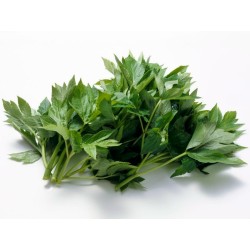
Ashitaba seeds (Tomorrow's...
Fiyat
€3,95
(SKU: MHS 100)
Seeds Gallery EU,
5/
5
<h2><strong>Ashitaba seeds (Tomorrow's Leaf) (Angelica keiskei)</strong></h2>
<h2><span style="color: #ff0000;"><strong>Price for Package of 5 seeds.</strong></span></h2>
<p><span>Angelica keiskei Koidzumi, commonly known under the Japanese name of Ashitaba (アシタバ or 明日葉 ashitaba, literally "Tomorrow's Leaf"), is a cold hardy perennial plant from the angelica genus with an average growth height of 50–120 cm. It is endemic to Hachijō-jima, though it is artificially cultivated in Izu Ōshima, Mikura-jima, Nii-jima, To-shima and parts of Honshū as well.</span></p>
<p><span>The plant's additional cultivar epithet koidzumi refers to botanist Gen'ichi Koizumi, while its Japanese nomenclature stems from the above-average regenerative capabilities it exhibits after injury. Harvesting a leaf at the break of day often results in a new sprout growing overnight, being visible the following morning.</span></p>
<p><span>Traditionally it is seen as a major contributor to the supposedly healthier, extended lives of the local residents, possibly due to the chalconoids that are unique to this species of angelica. At one point in Edo period, the haulm's yellow sap was effectively used in the external treatment of smallpox, which prompted Kaibara Ekken to describe the herb in his Yamato honzō (大和本草), under the name of ashitagusa (鹹草), as "a powerful tonic drug." In folk medicine it is claimed to be diuretic, tonic, to improve digestion, and, when applied topically, to speed wound healing and prevent infection. Also, its nutritive qualities are said to be the factor behind the internal exiles' and their families' never waning stamina in the face of their arduous compulsory labor.</span></p>
<p><span>For similar reasons, it very widely serves as pasture for cows, reckoned to improve the quality of milk as well as the yield and to maintain cattle health at the same time. It should be pointed out that most of these claims have yet to be proven in clinical trials, while studies have substantiated the presence of furocoumarins in several of these plants' components. Furanocumarin is an agent known to increase skin sensitivity to sunlight and may cause dermatitis.</span></p>
<p><span>Nonetheless, modest conditions for cultivation and fast rate of growth, with optimal temperatures ranging between 12-22 degrees, have led many locals to plant ashitaba in herb gardens, flower pots, and backyards. These days the main use of their stipes, leaves, and taproots is in regional cuisine, where they are prepared as soba, tempura, shōchū, tea, ice cream, pasta etc. The Mikura-jima variety might excel in this regard as it is reputed to be less bitter than others.</span></p>
<p><span>Note that ashitaba closely resembles Angelica japonica, but can be distinguished by its blooming period, which lasts from May to October whereas A. japonica's blooming period lasts only between May and July. Another indicator is the characteristic color of its sap.[2] The larvae of the Common Yellow Swallowtail are known to feed frequently on the plant.</span></p>
<h2><span>Medicinal properties</span></h2>
<p><span>A. keiskei has been claimed to exhibit cytotoxic, antidiabetic, antioxidative, anti-inflammatory, antihypertensive, and antimicrobial properties via in vitro studies, but the efficacy of these qualities have yet to be confirmed in vivo.[3] Among current investigations is its potential as a nerve growth factor,[4] as well as potential usefulness in cancer, menopause, and other conditions.[5] Ashitaba may have positive effects on circulation by preventing red blood cells from clumping.</span></p>
<h2><strong><span>Claims of being a vegetable source of vitamin B12</span></strong></h2>
<p><span>Although it is often suggested that A. keiskei is a vegetable source of vitamin B12 (cyanocobalamin), recently published, peer-reviewed scientific investigations of pharmacology and phytochemical constituents of interest report nothing that substantiates this claim.[7][8] Traditional methods for measuring vitamin B12 in foods are compromised by contaminants (e.g. soil, bacteria, etc.) that contain detectable concentrations of inactive B12 analogs, which may explain the origin of this belief.[9] More recent studies reveal certain mushrooms and algae as the only naturally occurring sources of B12 outside of the animal kingdom.[10] Of these, only Chlorella has demonstrated the ability to reduce methyl malonic acid (MMA) levels (a product of B12 deficiency) in human subjects.</span></p>
<p><strong><span>Soak seeds overnight in cool, non-chlorinated water and then refrigerate the seeds (approximately 40 degrees F) in the moist medium for 3 days. </span></strong></p>
<p><strong><span>The moist medium could be moist sand, moist potting soil, moist coir or moist peat. </span></strong></p>
<p><strong><span>Note that our recommendation is MOIST, not SODDEN or VERY WET and that we are recommending REFRIGERATION not FREEZING. </span></strong></p>
<p><strong><span>After this pretreatment, plant the (still moist) seeds. </span></strong></p>
<p><strong><span>Sow on surface, barely cover with soil and press in firmly and keep evenly moist until germination. </span></strong></p>
<p><strong><span>Use a greenhouse, shade house or grow lights. </span></strong></p>
<p><strong><span>Germination Temperature is around 20C/68F</span></strong></p>
<p><strong><span>Germination occurs 30 to 60 days after sowing. </span></strong></p>
<p><strong><span>Seedlings are slow-growing and will require about 60 days to transplant. </span></strong></p>
<p><strong><span>Once past the seedling stage, the plant is fast growing. </span></strong></p>
<p><strong><span>The plants prefer rich, deep, ever moist, well-drained soil and full sun to part shade. </span></strong></p>
<p><strong>Water every other day.</strong></p>
MHS 100 (5 S)


Dev bitki (dev meyveli)
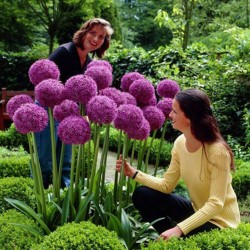
Dev Soğan Tohumları -...
Fiyat
€1,95
(SKU: MHS 31)
Seeds Gallery EU,
5/
5
<h2><strong>Dev Soğan Tohumları - Globemaster (Allium Giganteum)</strong></h2>
<h2><span style="color:#ff0000;"><strong>5 tohum paketi için fiyat.</strong></span></h2>
<p>Bu çiçekler kesinlikle çok büyük! Geniş bir 6 - 8 "genişliğindedirler! Bu Allium çeşidi mükemmel bir kuru çiçek yapar. Ayrıca arıların da favorisidir.</p>
<p>Wikipedia:</p>
<p>Dev Soğan olarak da bilinen Allium giganteum, soğan cinsinin çok yıllık soğanlı bir bitkisidir, çiçekli bir bahçe bitkisi olarak kullanılır ve 2 metreye kadar büyür. Ortak uygulamada en uzun süs Allium'dur. Yaz ortalarının başlarında, yoğun mor çiçek başlarının (umbels) küçük küreleri, ardından çekici tohum başları görülür. Popüler bir çeşit olan 'Globemaster' daha kısadır (80 santimetre), ancak çok daha büyük, derin mor, çiçek başları (15-20 santimetre) üretir. Her iki çeşide de Kraliyet Bahçe Bitkileri Derneği Bahçe Liyakati Ödülü verilmiştir.</p>
<p>İSİM: Dev Allium "Globemaster"</p>
<p>BİLİMSEL AD: Allium Giganteum</p>
<p>RENK: Mor 6-8 ”yuvarlak çiçek başları</p>
<p>BLOOM ZAMANI: İlkbahar Sonu - Yaz Ortası</p>
<p>SERTLİK BÖLGE: 4-9</p>
<p>Yayılma:</p>
<p>Her zaman steril ekilen toprak kullanın.</p>
<p>Dikim ortamını nemlendirin, ince tohumları toprağa yerleştirin ve hafifçe örtün.</p>
<p>Tencereyi plastik bir torbaya yakl. 5 ° C.</p>
<p>3-4 hafta sonra, tencereyi çimlenme sıcaklığına, yakl. 15 ° C.</p>
<p>1- içinde? aylar tohumlar çimlenir, çimlenme çok yavaş olabilir.</p>
MHS 31





